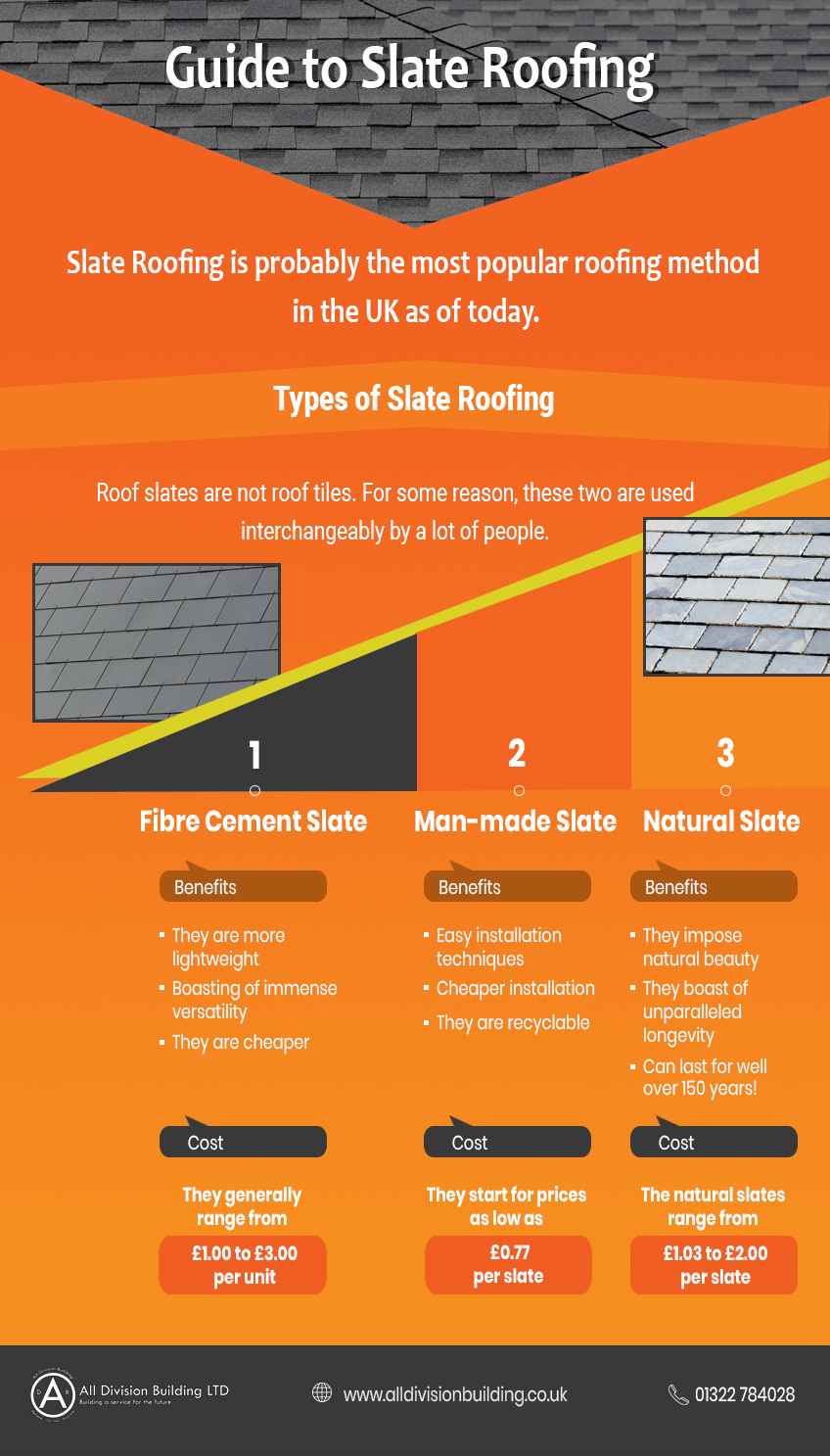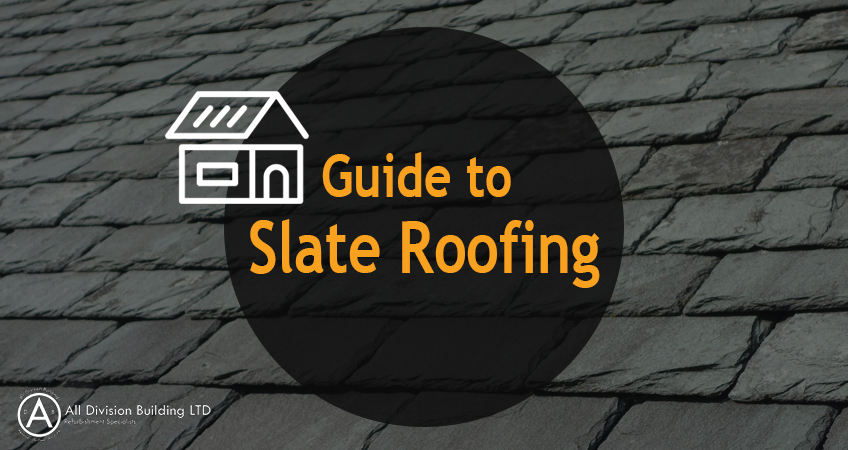Slate is a fine-grained metamorphic rock. It can be cut into shingles and used as a roofing material. This system of roofing is what is known as slate roofing.
Slate Roofing is probably the most popular roofing method in the UK as of today. This is because of their amazing aesthetics, durability, natural finish, and overall cost-effectiveness. Because of the variety of options available, however, deciding on the kind of slate roofing you want over your head might be tricky. As we explain in details the different types and styles of slate roofs, with their perks and disadvantages, we know we’ll help you conclude.
Roof slates are not roof tiles. For some reason, these two are used interchangeably by a lot of people. While roof slates are made from slate, roof tiles are made from clay or concrete.
Types of Slate Roofing
There are three types of Slate roofs. These include:
- Natural Slate
- Man-made Slate
- Fibre Cement Slate
1. Natural Slate
The natural slate is the typical slate gotten from the slate rock itself. It is the most original kind of slate, whose appearance cannot be manufactured artificially. For buildings that need to depict a historical heritage or some form of natural grandeur, natural slates are the best.
Benefits
- They impose natural beauty like no other kind of roofing materials.
- They boast of unparalleled longevity. Natural slates can last for well over 150 years! This is because of their extreme durability against harsh weather conditions, even freezing temperatures.
- They do not fade or wear as quickly as other roofing materials do. They are so durable, they most times outlive the buildings they cover.
- Natural slates require little to no maintenance costs. If they are installed properly, you will barely have any problems with them, ever again.
Requirements
While all-natural slate is good, there are particular properties that contractors look out for, when choosing, and constructing natural slates. If contractors look out for them, you should too! Some of them are:
Thickness: Their depth usually determines the quality of natural slates. Regardless, the higher the width of the slate, the heavier your roof is. The best thickness is 4 mm, while the weighty ones are 9 mm.
Pitch: This is the amount of degree of overlap, that each slate must have over the neighbouring slate. The headlap, explicitly, is when the head of a slate is overlapped by another, two courses above it. The lower the pitch, the more the overlap. Pitch determines overall durability and water resistance. Hence, there is no such thing as a pitch that is too low. For natural slates, however, 25° is the minimum that is required. This generally means a minimum of 85mm headlap. Pitch is also dependent on the thickness of the slate. The heavier the slate, the lower the required pitch.
Carbonate Content: The carbonate content of purchased natural slate must be detailed. This is because the carbonate content, like the thickness, determines roof quality. Slates with carbonate contents that are too high will suffer varying colour changes when exposed to the elements. The benchmark is usually 20%.
BS EN 12326: This is the European standard against which all-natural slates are measured. BS EN 12326 – 1 details product specification, and BS EN 12326 – 2 outlines methods for determining the quality of the slate.
Manufacturer: In the UK, SIGA is one of the forerunners of natural slate harvesters. They are so sure of the authenticity of their products that some slates have over 75 years of warranty. They also major in the importing of Spanish slates, which are peculiar for their aesthetics and simultaneous cost-effectiveness.
Cost
The most original form of slates, one should expect that natural slates be the most expensive of the three types of slates. There is, however, no fixed price, since even natural slates are of different grades and class. Overall, the amount will depend on the quantity purchased, as bulk purchase reduces the unit cost. Generally, however, the natural slates range from £1.03 to £2.00 per slate. You can contact us for more details.
Quantity needed per square metre
The amount of natural slate, like all other types of slate, required per square metre, is dependent on the kind of slate bought. Two examples are given below.
| Size | Type | Thickness | Tiles per square metre |
| SIGA 56V Natural Slate | 500 x 250mm | 4.2mm | 20 tiles |
| SIGA 35 Natural Slate | 400 x 250mm
400 x 375mm |
8mm | 25 tiles |
Installation
Unlike other types of roofs, slate roofs must be installed by professionals called skaters. This is because of the level of complexity it involves. Bottom line, installation could be difficult, expensive, and time-consuming.
2. Man-made Slate
These are made from a combination of ground slate, and synthetic resin. Human-made slates attempt to afford the same natural looks that the natural slates have, and they do an excellent job at this mimicry. They also have modern design, with easy installation techniques.
Benefits
- Easy installation techniques
- Of the three types of slates, they have the lowest unit prices
- Cheaper installation
- They are lightweight, and will thus prevent the need for extra reinforcements in the building
- They are recyclable, and hence, environmentally friendly
Durability
Human-made slates are not nearly as durable as the natural slates. They are designed to last for only 30 years. Regardless, when viewed in tandem with the cheap cost of purchase and installation, it seems to be the favourite choice for commercial buyers.
Cost
Again, the cost is dependent on the type and quantity you purchase. Some names in the industry are truly credible. Some of these include the Red Cambrian Grey and the Brislate Countess Slate. The former has 60% natural slate, while the latter has 80% natural slate. With 80% content of the real stuff, the Brislate Slate could just easily pass for the natural slate. With its reasonable price, it continues to be the top customers’ choice. While there may be no definite ceiling to the price per unit, they start for prices as low as £0.77.
Quantity needed per square metre
Using the Red Cambrian Grey and Brislate Slate as case studies:
| Size | Type | Tiles per square metre |
| Red Cambrian Grey | 300 x 336mm | 13.3 tiles |
| Brislate Countess Slate | 510 x 255mm | 20 tiles |
Pitch
Unlike natural slates, the minimum pitch that Man-made slates require is pegged at 15°, due to the interlocking technology they possess.
Installation
The hallmark of man-made slates, they have seamless installation costs and techniques. Also, their tiles come mostly with interlocking technology.
3. Fibre Cement Slate
These are made from a mixture of cement, fibre, and mineral additives. They bear the least semblance to the natural slates.
Benefits
- They are more lightweight than natural slates. This way, lesser costs are incurred on reinforcements.
- They are cheaper.
- They provide options along with a greater variety of roof structure, boasting of immense versatility.
- They are particularly useful for refurbishment projects.
Durability
Similar to the Man-made slates, manufacturers of fibre cement slates guarantee that they can last for up to 30 years. You can expect that regular maintenance can as much as double this expectancy period.
Cost
Due to the materials used, fibre cement slates are more cost-effective than natural slates. However, they are not as cheap as man-made slates. They generally range from £1.00 to £3.00 per unit.
Quantity needed per square metre
Prominent fibre cement products include Cembrit Jutland and Marley Birkdale Slate. The quantities of these you’ll require are:
| Size | Type | Tiles per square metre |
| Cembrit Jutland | 600 x 300mm | 13.3 tiles |
| Marley Birkdale Slate | 600 x 300mm | 20 tiles |
Pitch
Because of the cement, these slates have greater flexibility. They can thus go as low as 15° pitch.
Installation
The short installation time of these slates is attributed to their pre-drilled holes.
In conclusion
Of the three types of Slate roofs, it is beyond any doubt, clear that the natural slates are the best. The cost-effectiveness of the other classes, however, are also worthy of note. Ultimately, no slate roof is terrible. You cut your coat according to your cloth.

